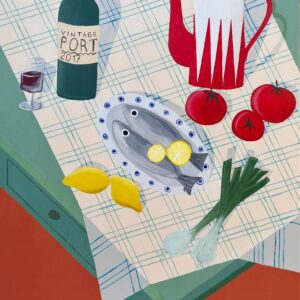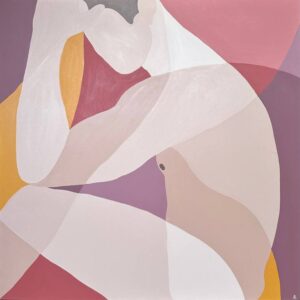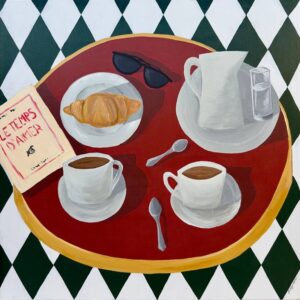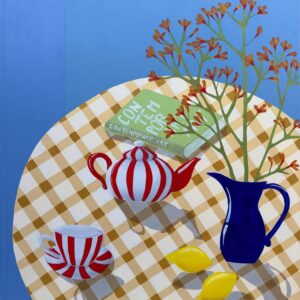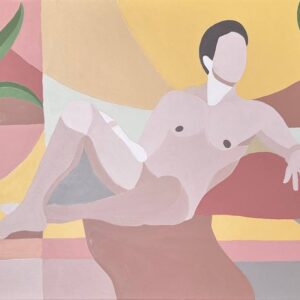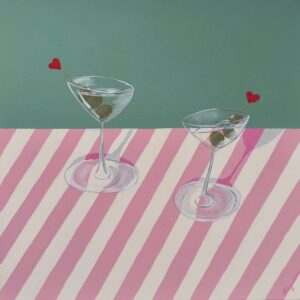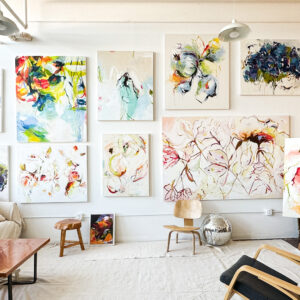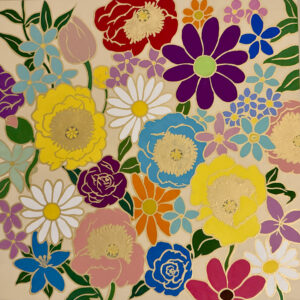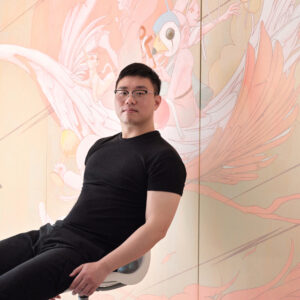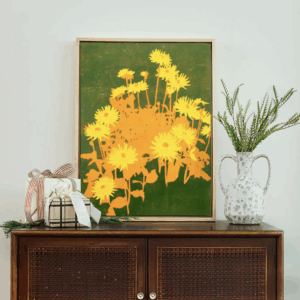One to Watch
 Memory and Intimacy with Aleksei Blagodarev
Memory and Intimacy with Aleksei Blagodarev
Switzerland-based artist to watch, Alexei Blagodarev, employs a variety of visual tools to create ordered canvases, elevating simple forms into pictorial harmony. Utilizing the efficiency of line and color, Alexei outlines scenes stylized to perfection, whether it’s tablescapes set for Apéro in his series ‘At the Table’ or vulnerable, nude men in the series ‘Coming Out’. While tablecloths use pattern to demarcate space in some works, male figures are fragmented by the very same geometric forms, disappearing into the background in others.
Alexei has been featured on a number of occasions by Saatchi curators. In his work, no brushstroke is misplaced, nor detail missed. Find out why Alexei Blagodarev is this month’s One to Watch.
Tell us about who you are and what you do. What’s your background?
I was born in Arkhangelsk, northern Russia, where I first became interested in art through traditional folk painting. As a child, I attended an art school focused on decorative wood painting, a craft rooted in local culture. Although I don’t have a formal academic art education, art has always been part of my life. I worked for many years as a florist and decorator, always drawing, always learning. When I moved to Saint Petersburg at 19, I found endless inspiration in the Hermitage. Matisse, Picasso, Malevich, and Kandinsky shaped my visual language and love for painting.
What does your work aim to say? What are the major themes you pursue in your work?
My work explores themes of presence, memory, and emotional intimacy. In my series “Around the Table,” I reflect on gathering as a quiet ritual—a moment suspended between “I” and “you,” between words and silence. The table becomes a metaphor for connection. I use everyday objects (cups, fruit, tableware) and turn them into witnesses of mood and time. In “Coming Out,” I explore vulnerability and identity through the male body. The figures are faceless and at rest so the viewer can step into them. Both series are about how silence can say more than narrative. They ask the viewer not to look at the image, but to feel it.
Can you walk us through your process for creating a work from beginning to end?
My process begins with a feeling, a certain emotional tension or atmosphere I want to express. I don’t sketch much. Instead, I collect fragments: a color, a shadow, a gesture. These spark the work. I build the composition carefully, but allow space for change. I often begin with rhythm and palette, letting those elements guide the rest. For me, painting is like choreography: a dialogue between control and surrender. I aim not to describe, but to distill something essential—something that lingers in silence.
How do you hope viewers respond to your works? What do you want them to feel?
I don’t aim to provoke; I want to invite. My work is about creating space for feeling, slowing down, and recognizing something in oneself. In “Coming Out,” I hope viewers respond with tolerance and openness—not only toward LGBTQ+ identities, but toward all forms of difference. The world feels increasingly harsh. We must honor each other’s choices, bodies, cultures, and ways of being with kindness. In “Around the Table,” I want the viewer to feel time. To feel how brief and precious life is and how easily we trade real connection for the distractions of screens. I hope these quiet scenes remind us to be present, gather, and love each other while we can.
How does your work comment on current social and political issues?
I don’t approach politics directly, but both of my series carry subtle social reflection. In “Around the Table,” I explore the loss of real human connection in our screen-driven lives. The table becomes a final physical space where presence still matters. In “Coming Out,” I speak to vulnerability—especially male vulnerability—as an act of honesty and tolerance. I hope both series encourage compassion, reflection, and attention to what we often overlook.
Who are your biggest influences and why?
Matisse inspires me through his wild and joyful use of color. His work makes you feel alive. Picasso taught me the value of freedom and reinvention. Malevich showed me the strength of simplicity. More broadly, I’m drawn to restraint in painting, film, or writing. I admire creators who say more through silence, emptiness, and rhythm than through detail.
Who are your favorite writers?
I’ve always loved Dostoevsky—his depth is timeless. Recently, I discovered Laurent Gounelle, and his book “The Man Who Wanted to Be Happy” resonated deeply. I’m drawn to authors who speak to the soul simply, but with honesty.
Do you prefer to work with music or in silence?
I always work with music. It sets the mood, fills the emptiness, quiets the mind, and helps me concentrate. Music becomes the background that lets the painting speak.
